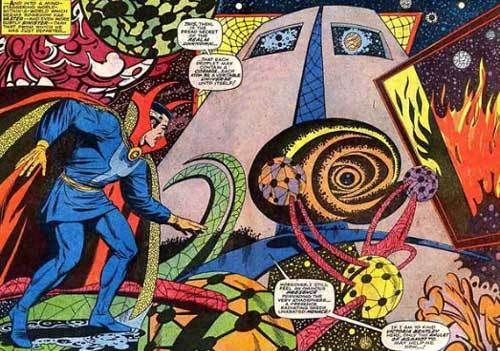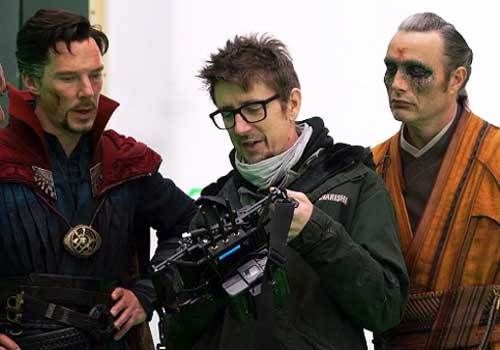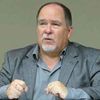Stef Ceretti is a master of movie magic.
And I’m not just saying that because Stef has been the visual effects supervisor on Academy Award-winning films like The Matrix. Or because of his ground-breaking work on FX-filled extravaganzas like Batman Begins, X-men: First Class, & Marvel’s Guardians of the Galaxy.
No, I’m called Ceretti a master of movie magic because – to date – he’s worked on three different motion pictures where magic was a key component of those films’ stories. With the first of these projects being Christopher Nolan’s The Prestige.

“In that case, because Chris was telling a story about magicians that was set at the end of the 19th century, he wanted the magic in this movie to look period appropriate,” Stef recalled during a recent phone call. “That’s when I told him that I was going to use some of the earliest motion picture effects sequences as inspiration for the effects that I’d be doing for The Prestige. As I told Chris, ‘This story is about illusion. And those guys who did the effects work on all those early movies, they were illusionists too. Which is why those films look the way that they do.’”
In the case of Harry Potter and the Goblet of Fire, Ceretti was a member of a team that obviously had to pattern the bulk of that motion picture’s magical FX on what had been done for the previous “Potter” productions, 2001’s Sorcerer’s Stone, 2002’s Chamber of Secrets and 2004’s Prisoner of Azkaban.
But what was challenging about Goblet of Fire was – because magic is taught differently at the Durmstrang Institute and the Beauxbatons Academy of Magic – that then meant that whenever the students & teachers from those schools performed spells, their magic had to look different from the sort of magic that anyone who’d ever been trained at Hogwarts could perform. And then when you factor in that this is the movie where Lord Voldemort makes his return … Well, that means that the FX team had to create a specific look for the sort of dark magic that the Death Eaters performed. So that meant that there were four distinctly different styles of magic in one movie. Which – as you might imagine – took the VFX team including Stef a lot of work to pull off.

Which brings us to Ceretti’s latest magical challenge, Marvel’s Doctor Strange (which is now available on Blu-ray & DVD). Given that this comic book character (who was introduced to the world in the July 1963 issue of “Stranger Tales”) is known as the Sorcerer Supreme, Stef knew that he now had to go to a whole ‘nother level when it came to doing visual effects for this film.
“Scott (Derrickson, the director of Doctor Strange) had some very distinct thoughts when it came to the way magic should look in this movie. Whenever possible, he wanted everyday objects to look & act in ways that are different from the way they behaved in the real world,” Ceretti continued. “Take – for example – how sparks behave in this movie. They may look like real sparks, but they certainly don’t behave like sparks behave in the real world when magic is being employed. The same goes with the buildings in Dr. Strange’s world. They’re made of materials that we all recognize. But as soon as magic is being used, these buildings start to move and distort and fractalize in ways that we’re just not used to seeing at all.”
So how did Stef & Scott come up with that distinctive look which Dr. Strange‘s visual effects showpieces have? They simply returned to the source material.

Example of the psychedelic stylings that Steve Ditko brought to Marvel’s “Doctor Strange” comic book back in the 1960s & 1970s.
“If you look at what Steve Ditko was doing with the ‘Doctor Strange’ comic book back in the 1960s & 1970s, it’s obvious that he was heavily influenced by all of the psychedelic stuff that was popular back then,” Ceretti said. “And because we wanted to get a sense of what had originally influenced Steve, we also looked at Escher prints and all these black light paintings that featured magical bolts.”
The downside of all this pre-production research was that the look for Doctor Strange‘s visual effects that Ceretti & Derrickson had ultimately arrived at was going to take an awful lot of R & D to properly pull off.
“And since we were originally supposed to start shooting in mid-2015, it looked like we really weren’t going to get the amount of time that we needed prior to the start of production. But then we got what we called the Benediction,” Stef laughed. “We called it the Benediction because Marvel really wanted Benedict Cumberbatch to play the title role in Doctor Strange. And when he wasn’t available, they actually pushed back the start of production ‘til November of 2015 so that Benedict would then be available to work on this movie. And it was that schedule change that then gave us the time we needed to do the necessary R & D on this film’s effects.”

Scott Derrickson (center) shares some “Doctor Strange” previz with Benedict Cumberbatch & Mads Mikkelsen prior to shooting one of this film’s action sequences.
And even now, Ceretti is extremely grateful for those extra few months of pre-production planning that he and his visual effects team got to do on Marvel’s Doctor Strange. For – when you watch the finished version of this Scott Derrickson film – there are FX-driven moments in this movie that look like they were impossible to pull off.
“Take – for example – the battle in Hong Kong where time is going backwards while these guys are fighting forwards. That sequence – all by itself – took us 23 days to stage and shoot because it was so complicated,” Stef recalled. “Likewise this movie’s magical mystery tour, which is when Doctor Strange is first learning about the Astral Plane. To capture the footage that we needed for that effects sequence, we first had to create this special rig with motion control cameras. And then poor Benedict had to be strapped into the thing, going upside down and sideways. He wound up being tossed in every direction just like a guy who is going through astronaut training.”
As you might expect, making a visual effects extravaganza like Doctor Strange isn’t just labor intensive. It’s also a hugely expensive proposition. The sort of project that any sensible studio exec would immediately steer clear of.

“But that’s what’s great about working for Marvel. They’re the ones who are now always actively pushing us to break new ground, effects-wise. To them, there’s no such thing as just another super movie. They’re the ones who keep telling us ‘Just go for it. Don’t be afraid. Don’t hold back,’ “ Ceretti enthused. “And it’s not just the visual effects people that Marvel has been talking to like that. It’s also the directors of its Cinematic Universe movies as well as the screenwriters who work on these films. They’re actively encouraging this sort of boldness from everyone who works on these projects. Which is why it’s such a super exciting time to be working at Marvel Studios.”
So with these sorts of marching orders, what sort of movie magic can we expect to see from Stef when it comes to the next Marvel Studios film that he’ll be doing visual effects on. Which is Ant-Man and the Wasp (which begins shooting down in Atlanta later this month).
“All I can say about that one is that Peyton Reed is directing again. And since he has a lot of very exciting ideas, us visual effects guys are going to have some very challenging sequences to begin working on shortly,” Ceretti concluded. “Which is pretty cool.”
